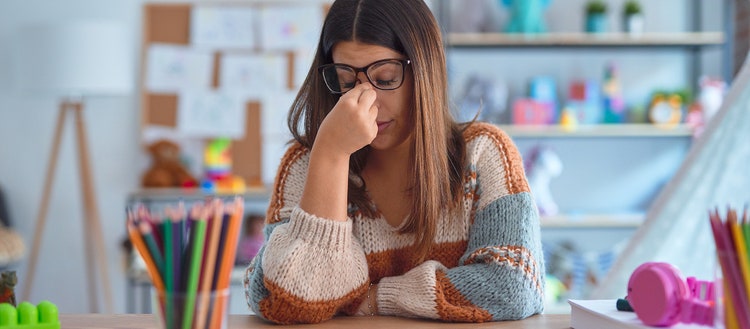Teachers are thinking twice about going back to school

Facing an unprecedented shortage of teachers, school districts across the country are scrambling to fill positions.
In this article
- Adapt training programs to prepare next generation of teachers in media and technology-rich classrooms
- Provide support for digital upskilling for teachers
- Empower teachers to empower students through creativity
This should come as no surprise. Earlier this year, the National Education Association (NEA) surveyed its members about stress and burn out in the teaching profession. Of the 3,600 educators who responded, 55 percent are considering an early exit from teaching because of the pandemic.
Teachers were already overworked, underpaid, and underappreciated. And the pandemic was a tipping point. Suddenly, teachers were expected to pivot to an online learning environment. In many cases, they lacked the digital means and support to make a smooth transition, adding to their stress. These last two plus years teachers were on the front line for their students and communities. Many teachers have reconsidered their profession with record numbers leaving altogether. United States school districts are facing more 300,000 vacancies this Fall according to the NEA.
Districts have scrambled to address an immediate teacher shortage. That means librarians are being asked to teach seventh-grade science. Administrators are trading their office for the front of the classroom. Military veterans are stepping up to serve in schools. Substitute teachers have been hired into full-time roles, leaving no actual substitutes. And some districts have even reduced the school week from five days to four. The list goes on and on.
How can we help prepare new teachers to enter classrooms across the county — and help qualified, experienced educators reconnect with the joy of teaching and prepare them — and their students — for long-term success? Our education systems need new ways to prepare and sustain teachers and to provide stronger support for this critical profession.
Adapt training programs to prepare next generation of teachers in media and technology-rich classrooms
Many teacher prep programs have often been slow to adapt. That means teachers are entering the classroom without the skills to support student success in today’s digital environments.
The pandemic accelerated change in classrooms. Today, there is a 1:1 student-device ratio in 90 percent of US middle and high schools, up from 50 percent before the pandemic.
ISTE, in partnership with the US Department of Education, has called on educator preparation programs (EPPs) to pledge to bridge this gap. By committing to teaching to ISTE standards, EPPs can graduate new teachers with skills that reflect the realities of today’s education landscape.
Provide support for digital upskilling for teachers
Many teachers adapted their teaching out of necessity during the pandemic and learned to teach online using new technologies. Digital portfolios, virtual collaboration, digital storytelling, and media creation are increasingly widely adopted in classrooms around the world. Most educators accept that the use of technology transcends subjects and grade levels and is here to stay.
Online platforms such as the Adobe Education Exchange provide free teaching resources and professional learning to help educators teach using today’s tools, whether they’re teaching math or social science. Our goal is to make it as easy as possible for both experienced and newer educators to leverage technologies to achieve their curricular goals and to explore new ways to engage students while boosting their digital literacy.
Empower teachers to empower students through creativity
Educators are embracing creativity as essential to student success in the classroom and beyond. Projects that required creative thinking, creative problem solving, and creative communication spur higher order thinking. Students have opportunities to synthesize their knowledge, to solve problems in unique ways, to see the impact of creative storytelling. All while learning how to be responsible digital citizens who are accountable for the content they create. Students also value opportunities to learn through creative projects. 78 percent of Gen Z students report they learn best by doing and creating
Whether through a drawing, photograph, video, song, or written report, tools such as Adobe Express for Education support curriculum goals and foster the creative skills that translates into long-term career success.
The past couple of years have required incredible creativity and resilience from individual educators. We need to honor these teachers and sustain their profession. Let’s help teachers re-discover the joy of teaching, of learning and of creating — and prepare the next generation of teachers well.
Find inspiration at the Adobe MAX conference with thousands of educators from around the world. You’ll find free virtual sessions focused on preparing the next generation with essential creative and digital literacy skills.